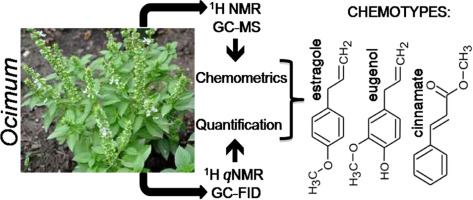Talanta ( IF 5.6 ) Pub Date : 2017-12-21 , DOI: 10.1016/j.talanta.2017.12.053 João Vito B. Freitas , Elenilson G. Alves Filho , Lorena Mara A. Silva , Guilherme J. Zocolo , Edy S. de Brito , Nilce V. Gramosa

|
The genus Ocimum (Labiatae) comprises 30 species found in tropical and subtropical regions of the planet, of which species O. basilicum L. and O. gratissimum are widely used in food and traditional medicine. Phytochemical studies on Ocimum have revealed a number of essential oil chemotypes, for example, eugenol, methyl chavicol, linalool, and methyl cinnamate. Since essential oils are commercially assessed according to their content, the aim of this study was to develop a simple and precise method for their qualitative and quantitative analysis using NMR spectroscopy combined with chemometrics. Seven essential oils from different species of Ocimum, an unknown sample, and a commercial sample were evaluated and the results compared to those from established and precise GC-MS and GC-FID methods. Chemometric evaluation from both 1H NMR and GC-MS data revealed three chemotypes: eugenol for O. gratissimum, O. micranthum, and O. tenuiflorum; estragole for O. basilicum, O. basilicum var. purpuracens, and O. selloi; and methyl cinnamate for O. americanum. The unknown and commercial species were classified as cinnamate and eugenol chemotypes, respectively. Despite the corroborating results, the chemometric analysis revealed the higher robustness (better adjustment) of the 1H NMR model compared to the GC-MS method in terms of certain statistical parameters. The 1H NMR method allows for the detection and quantification of organic compounds in a complex mixture without the need for certified standard compounds. Although GC-MS and GC-FID were able to detect five compounds not observed by NMR spectroscopy, the four most important metabolites (eugenol, estragole, methyl cinnamate, and eucalyptol) were more readily detected and quantified by 1H NMR.
中文翻译:

NMR和GC数据集的化学计量分析,用于化学鉴定来自不同罗汉果属植物的精油
Ocimum(Labiatae)属包括在地球的热带和亚热带地区发现的30种,其中O. basilicum L.和O. gratissimum广泛用于食品和传统医学中。对Ocimum的植物化学研究显示许多精油的化学型,例如丁子香酚,甲基查维索尔,芳樟醇和肉桂酸甲酯。由于精油是根据其含量进行商业评估的,因此本研究的目的是开发一种简单而精确的方法,以结合NMR光谱和化学计量学进行定性和定量分析。来自不同品种的罗勒的七种精油,未知样品和商业样品进行了评估,并将结果与已建立的精确GC-MS和GC-FID方法的结果进行了比较。来自两个化学计量学评价1 H NMR和GC-MS的数据显示三种化学:丁子香酚为O. gratissimum,O.山白,和O. tenuiflorum ; 草蒿为O.罗勒,O.罗勒变种。紫癜和O. selloi ; 肉桂酸和肉桂酸甲酯用于美洲稻(O.美洲)。未知物种和商业物种分别分类为肉桂酸酯和丁子香酚化学型。尽管有确凿的结果,但化学计量学分析显示该产品具有更高的鲁棒性(更好的调节)。就某些统计参数而言,1 H NMR模型与GC-MS方法进行了比较。的1种1 H NMR方法允许检测和在复杂的混合物中的有机化合物的定量而不需要认证的标准化合物。尽管GC-MS和GC-FID能够检测出NMR光谱中未观察到的五种化合物,但通过1 H NMR更容易检测和定量四种最重要的代谢物(丁子香酚,雌二醇,肉桂酸甲酯和桉油醇)。











































 京公网安备 11010802027423号
京公网安备 11010802027423号